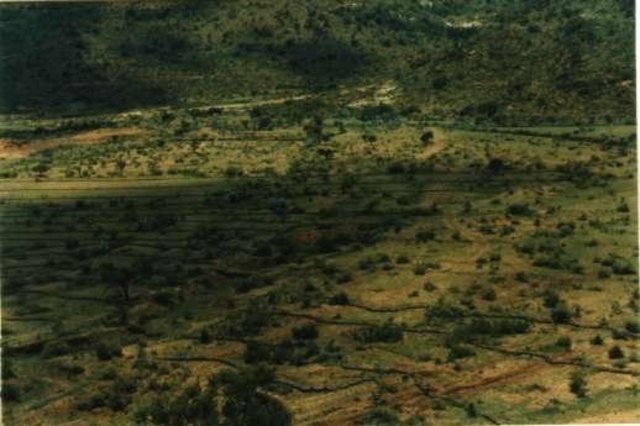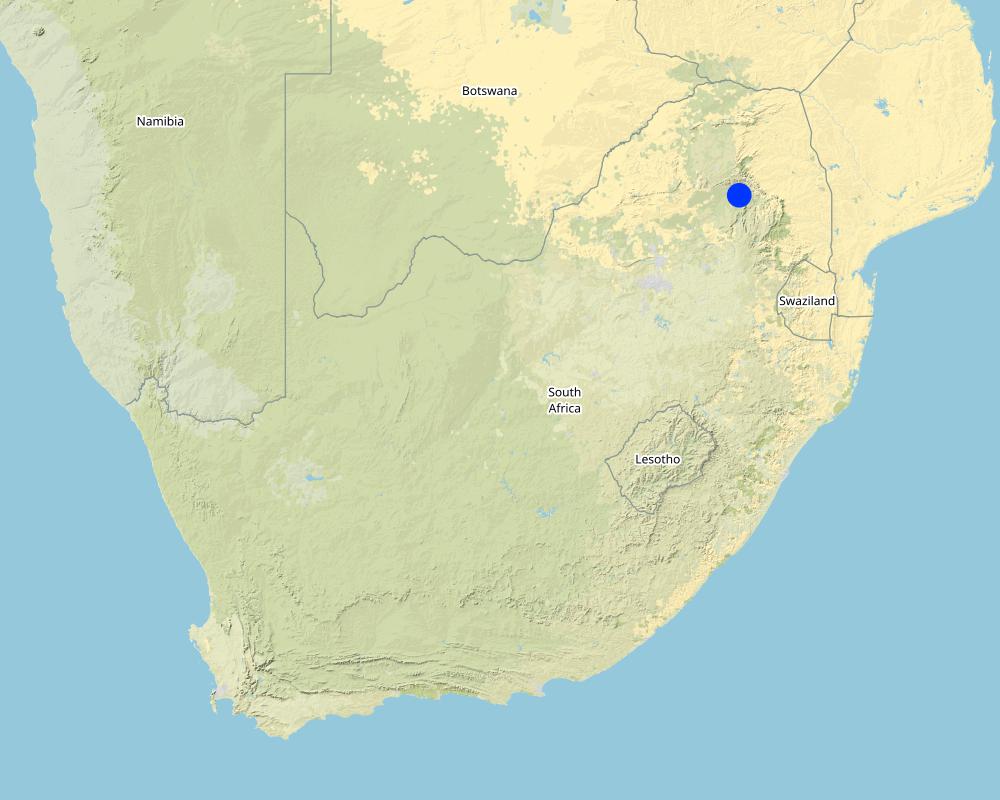Assistance to community [South Africa]
- Creation:
- Update:
- Compiler: Philippe Zahner
- Editor: –
- Reviewers: Fabian Ottiger, Joana Eichenberger
approaches_2548 - South Africa
View sections
Expand all Collapse all1. General information
1.2 Contact details of resource persons and institutions involved in the assessment and documentation of the Approach
Name of the institution(s) which facilitated the documentation/ evaluation of the Approach (if relevant)
Swiss Agency for Development and Cooperation (DEZA / COSUDE / DDC / SDC) - Switzerland1.3 Conditions regarding the use of data documented through WOCAT
The compiler and key resource person(s) accept the conditions regarding the use of data documented through WOCAT:
Yes
1.4 Reference(s) to Questionnaire(s) on SLM Technologies

Old Motor Tyre Contours [South Africa]
Old motor tyres and/or vegetation along contours.
- Compiler: Andrei Rozanov
2. Description of the SLM Approach
2.1 Short description of the Approach
Community requested assistance to combat soil erosion, only possible when 'Drought Relief Funds' became available.
2.2 Detailed description of the Approach
Detailed description of the Approach:
Aims / objectives: During the national drought of 1992, the Government made funds available for job creation to temporarily alleviate poverty in the rural areas. This community, with a population of approximately 4000, applied for funds, and suggested that the funds be used to combat soil erosion within their communal area of 3800 ha. The area was inspected by technicians from the then Lebowa Government: Directorate Agricultural Engineering, and a project site was identified where both proven high technology methods, as well as novel and unproven low technology biological methods, which can easily be adopted by relatively unskilled workers from the community, could be tried. Work started in 1992 with sufficient funds for six months. Fortunately, for the project, the national drought continued and funds were made available again during the subsequent three years for six monthly periods. No work has been done on the project since 1996 because of a lack of funds. In view of the visible improvement of the environment, the community is keen to expand the project to include more techniques to make the project more viable. The project has proved to be highly educational, not only to the local community, but also to all other communities who have visited the project. A prime example is that of the two communities from the Western Region who have adopted and adapted similar techniques at their own projects.
2.5 Country/ region/ locations where the Approach has been applied
Country:
South Africa
Region/ State/ Province:
Sekhukhuneland, Northern Province
Map
×2.6 Dates of initiation and termination of the Approach
Indicate year of initiation:
1992
2.7 Type of Approach
- project/ programme based
2.8 Main aims/ objectives of the Approach
The Approach focused mainly on SLM with other activities (Job creation. Empower the community to practice conservation, increase production of their natural resources and to improve their quality of life. Improve biodiversity. Demonstration model for researcher & other communities.)
Rehabilitation of the environment by trapping run-off rain water to plant trees, grass and other vegetation to improve the general biodiversity.
The SLM Approach addressed the following problems: Soil degradation caused by water erosion as a result of over utilisation.
2.9 Conditions enabling or hindering implementation of the Technology/ Technologies applied under the Approach
availability/ access to financial resources and services
- hindering
government job creation funds
Treatment through the SLM Approach:
legal framework (land tenure, land and water use rights)
- enabling
The existing land ownership, land use rights / water rights helped a little the approach implementation: help and hinder low, n/a
knowledge about SLM, access to technical support
- hindering
department of agriculture
Treatment through the SLM Approach:
3. Participation and roles of stakeholders involved
3.1 Stakeholders involved in the Approach and their roles
- local land users/ local communities
existing groups of land users; Specific ethnic groups:: Only one group in area.; Working land users were work equally divided between men and women
Involvment of socially and economically disadvantaged groups: With discussion, the Phaahla Mohlaka tribe.
- national government (planners, decision-makers)
Department of Agriculture - Engineering Division.
If several stakeholders were involved, indicate lead agency:
University of the North, Department of Agriculture
3.2 Involvement of local land users/ local communities in the different phases of the Approach
| Involvement of local land users/ local communities | Specify who was involved and describe activities | |
|---|---|---|
| initiation/ motivation | interactive | Mainly:public meetings; partly: rapid/participatory rural appraisal; Community meeting never regularly, meeting as often as needed, on side participation. |
| planning | interactive | rapid/participatory rural appraisal; The specialists planned and discussed it with the people |
| implementation | interactive | Mainly: casual labour; partly: responsibility for major steps; The specialists planned and discussed it with the people |
| monitoring/ evaluation | interactive | measurements/observations; Observation by technical staff, regularly reporting to the Department |
| Research | passive | on-farm; Continuous contact while working on the project. |
3.4 Decision-making on the selection of SLM Technology/ Technologies
Specify who decided on the selection of the Technology/ Technologies to be implemented:
- mainly SLM specialists, following consultation with land users
Explain:
consultative. Suggestions are made by technical staff to the local community for ratification.
Decisions on the method of implementing the SLM Technology were made by mainly by SLM specialists with consultation of land users. consultative. Mutual discussion between technical staff and local community.
4. Technical support, capacity building, and knowledge management
4.1 Capacity building/ training
Was training provided to land users/ other stakeholders?
Yes
Specify who was trained:
- land users
Form of training:
- on-the-job
Subjects covered:
People were instructed how to do the job, but not real training.
4.2 Advisory service
Do land users have access to an advisory service?
Yes
Describe/ comments:
Name of method used for advisory service: Government extension staff; Key elements: Range land management; 1) Advisory service was carried out through: Government's existing extension system 2) Advisory service was carried out through: Government's existing extension system; Extension staff: Mainly government employees
Advisory service is inadequate to ensure the continuation of land conservation activities; Too few officers adequately conversant with SWC.
4.3 Institution strengthening (organizational development)
Have institutions been established or strengthened through the Approach?
- no
4.4 Monitoring and evaluation
Is monitoring and evaluation part of the Approach?
Yes
Comments:
bio-physical aspects were ad hoc monitored through observations
technical aspects were regular monitored through observations
There were several changes in the Approach as a result of monitoring and evaluation: 1) Grass growing where there were none. 2) Numbers of grass species have increased considerably. 3) Gullies are stabilizing. 4) Water run off reduced.
4.5 Research
Was research part of the Approach?
Yes
Specify topics:
- technology
Give further details and indicate who did the research:
Determine sediment deposit and erosion control of the techniques.
Research was carried out on-farm
5. Financing and external material support
5.1 Annual budget for the SLM component of the Approach
If precise annual budget is not known, indicate range:
- 10,000-100,000
Comments (e.g. main sources of funding/ major donors):
Approach costs were met by the following donors: government (national - Government Drought Relief): 100.0%
5.2 Financial/ material support provided to land users
Did land users receive financial/ material support for implementing the Technology/ Technologies?
Yes
If yes, specify type(s) of support, conditions, and provider(s):
A daily wage is paid by means drought relief job creation.
5.3 Subsidies for specific inputs (including labour)
Comments:
A daily wage is paid by means drought relief job creation.
5.4 Credit
Was credit provided under the Approach for SLM activities?
No
6. Impact analysis and concluding statements
6.1 Impacts of the Approach
Did the Approach help land users to implement and maintain SLM Technologies?
- No
- Yes, little
- Yes, moderately
- Yes, greatly
Did the Approach improve issues of land tenure/ user rights that hindered implementation of SLM Technologies?
- No
- Yes, little
- Yes, moderately
- Yes, greatly
The problem is unlikely to be overcome in the near future. Because of no individual ownership
Did other land users / projects adopt the Approach?
- No
- Yes, little
- Yes, moderately
- Yes, greatly
Too early to comment.
6.3 Sustainability of Approach activities
Can the land users sustain what has been implemented through the Approach (without external support)?
- no
If no or uncertain, specify and comment:
It is a social problem, cause in human nature.
6.4 Strengths/ advantages of the Approach
| Strengths/ advantages/ opportunities in the land user’s view |
|---|
| improvement of the general economic situation (How to sustain/ enhance this strength: Expanding it) |
| increase job creation (How to sustain/ enhance this strength: But only for a short time) |
| Strengths/ advantages/ opportunities in the compiler’s or other key resource person’s view |
|---|
| At the beginning the workers regarded the work mainly as a source of income (How to sustain/ enhance this strength: Lack of understanding. After some rain had fallen that they came to realise what was being accomplished, and their enthusiasm grew steadily from that time.) |
| increase job creation (How to sustain/ enhance this strength: But only for a short time) |
| improvement of the general economic (How to sustain/ enhance this strength: Expanding it) |
6.5 Weaknesses/ disadvantages of the Approach and ways of overcoming them
| Weaknesses/ disadvantages/ risks in the land user’s view | How can they be overcome? |
|---|---|
| lack of funds | |
| no individual benefits for the local |
| Weaknesses/ disadvantages/ risks in the compiler’s or other key resource person’s view | How can they be overcome? |
|---|---|
| no individual benefits for the local | Land tenure |
| lack of funds | Find more funds |
7. References and links
7.1 Methods/ sources of information
- field visits, field surveys
- interviews with land users
7.2 References to available publications
Title, author, year, ISBN:
Preliminary Report Geen Einde.Request for funding.Geen Einde - Trees planted so far.
Available from where? Costs?
C.W. SpiesC.W. SpiesC.W. Spies
Links and modules
Expand all Collapse allLinks

Old Motor Tyre Contours [South Africa]
Old motor tyres and/or vegetation along contours.
- Compiler: Andrei Rozanov
Modules
No modules


